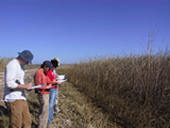The specific goal of the program at this time is to develop and field-test monitoring protocols that will eventually be used in a national monitoring effort. Because marsh birds are rarely seen by observers and are often less vocal than other birds, surveyors typically broadcast vocalizations of target species to improve detection probability. However, little is known about the pros and cons of call-broadcast surveys in a multi-species survey effort. Hence, we are currently examining the following aspects of this survey methodology:
- comparing temporal variation in vocalization probability between passive (no broadcast) and call-broadcast surveys;
- comparing observer bias between passive and call-broadcast surveys;
- quantifying effects of broadcasting inter- and intra-specific calls on vocalization probability.
The resultant protocols are being proposed for use in a continental marsh bird monitoring program for North America whereby survey routes will be chosen as part of a continental sampling design. Data collected from such a program will provide estimates of population trend at the regional, national, and continental scale.


